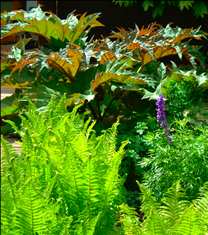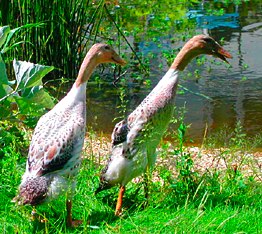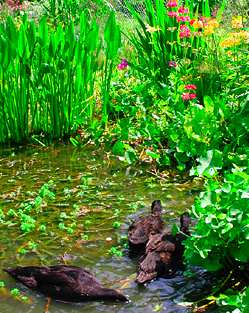|
Making the ideal decorative duck pond First published in the IRDA Yearbook 2003 The dominating
feature of our garden is the 25’ diameter pond which we excavated
just after we moved in. Our house adjoins some old gravel-pits,
now a private lake with a wonderful range of wildlife and rare wildfowl.
The original purpose of the pond was to lure wildlife from the gravel
pits into the garden, a plan that met with rapid success; before
long dragonflies, grass snakes and kingfishers were taking a dip
freely within view of the back door. And then came the ducks! Although I didn’t design the pond with them in mind, I found I had created a good duck pond, one which seems to have stood up to their attempts to destroy it fairly well. However a number of neighbours have given up on duck keeping because they wrecked the garden pond, so it’s worth considering some of the problems.
We also protected the edges with felted pond underlay before burying them under several inches of riddled soil/gravel for added protection from erosion/UV damage, and for a natural appearance. Adding sufficient quantity of oxygenating plants (such as Elodea crispa, (Canadian pondweed) will help stabilize the situation, but not as much as allowing for a larger volume which will react to temperature changes much slower. Ours is 4’ at it’s deepest point. I wouldn’t even consider making one less than 10’ or 12’ across and 24" deep. If they pond is large enough you won’t need pumps, filters or bottles of algicide! Plants Good examples
include: Marsh Marigolds (Caltha sp.), Mares Tails (Equisetum
sp.), Shuttlecock ferns (Mattheucia struthiopteris),
Miscanthus grasses (M.sinensis and the giant M.floridulus),
Pickerel weed (Pontederia sp.), all Petasites sp.,
decorative rhubarb (Rheum palmatum) Water irises and primulas are not quite as robust, but still good( esp. P. florinidae and P. bulleyana, which will self-seed freely possibly even aided by dabbling). Some of the Crocosmia family are very good, esp. C. paniculata and ‘Lucifer’.Planting the water edge with rapidly spreading species such as Creeping Jenny, Pennyroyal, Red Peppermint (or watermint) and Mimulus. The fibrous stems and roots will help stop dabbling bills from eroding the soil around the banks. I plant directly into soil/gravel which covers the liner. These tough plants soon form a dense mat of roots, rhizomes which form a good defence to probing bills.
For more gardenin
information/inspiration visit Arborvitae,
my online gardening magazine site. |
Benefits
to ducks
Some plants
can also cause ducks problems. Parrot’s feather myriophyllum
has very long stems in which younger ducks can become entangled. Never allow young and adult birds to mix in a pond; adult drakes will hold youngsters under the water and drown them! Don’t assume
just because they have access to lots of water that young birds
won’t suffer from sunstroke; I try to keep young birds away
from water during the hottest times, as they can exhaust themselves
in water very quickly. Finally, if you’re prone to brazen, midday fox attacks (as we now are) don’t assume they will be safe on the water. Some birds instinctively head for the duck house rather than the water, and I doubt they’d be safe on the water anyway!
|
|
| blacks | silverwildfarbig | chocolatesilver | gallery | silkies | mosaics | for sale | misc. | contact | ||


